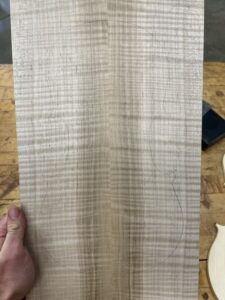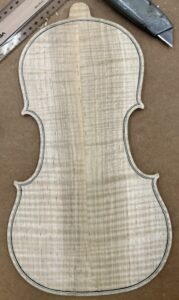by Reuben Hicks
I am an ETAD Major and have worked as an Assistant Forestry Technician for three years in my primary position. I had the opportunity to do an independent violin making class with Dr. Gary Mahoney this semester.
The first stage of violin making and one of the most important is selecting the wood. Traditionally, violins are made using curly sweet maple for the back, sides and neck and spruce for the top of the instrument. When talking to my supervisor, John Hite, Forestry Horse Program Specialist about my project, he said he had some curly maple that he salvaged from a blowdown in the Berea College Forest that had no value to log buyers. He offered to show me the slabs that he milled, and I was able to find a couple of beautiful pieces suitable for making a violin. After wood selection, I cut the wood to size and book-match them (glued them together).


I used the 1742 Giuseppe Guarneri ‘del Gesù’ violin as my model. I 3D modeled the back and top using CAD and then cut the back and top using the CNC machine. I left the back and top plates thicker than the model so I could gauge the density of the wood by tapping and listening to the notes they made. After getting their tap tones, I was able to get them to the right thickness using thumb planes and scrapers. I bent the sides using a heated iron and glued everything with the traditional violin maker’s hide glue. Though I did not finish the violin in one semester, I plan on finishing it over the summer. The project is unique because it tied together my major, woodworking, my Berea labor position, and music (I have played the violin for 18 years). I enjoyed it because it connected so many of my interests and challenged me to learn new skills and problem solve.


